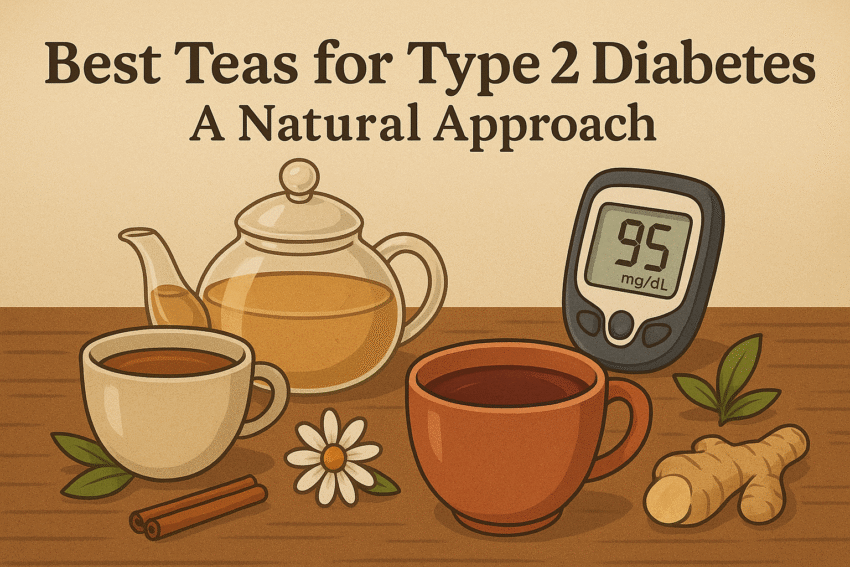A Narural approach for Blood Sugar Control
Let’s spill the tea—literally—on how your teacup might actually help balance blood sugar.
If you’re managing Type 2 Diabetes (or just trying to avoid it), chances are you’ve already been told to ditch the sugar, move more, and keep a close eye on carbs. Sound advice. But here’s something more delightful: some teas may help support healthy blood sugar levels.

Yes, your cozy tea ritual might double as a simple wellness habit—and that’s worth steeping over.
In this post, we’re diving into the top teas believed to help with blood sugar, what the research says, how to brew them, and why tea time just might be the tastiest part of your day.
How Can Tea Help with Type 2 Diabetes?
First, a quick note: tea isn’t a cure, but many herbal and traditional teas contain plant compounds that may help the body use insulin more efficiently, reduce inflammation, and even slow down carb absorption. Pair that with zero sugar (if you’re not adding sweeteners), and you’ve got a health-friendly beverage that feels indulgent.
Top 5 Teas That May Help With Blood Sugar
Here are the heavy hitters in the tea world when it comes to supporting glucose control.

- Cinnamon Tea
Cinnamon is practically a kitchen superhero. Studies suggest it can increase insulin sensitivity and lower fasting blood glucose levels. When made into a tea, it’s warm and spicy, making it a perfect cozy-night companion.
How to brew: Steep 1–2 cinnamon sticks in hot water for 10–15 minutes. For extra flavor, add a slice of orange or a dash of clove. - Green Tea
Green tea is loaded with catechins, powerful antioxidants that may help regulate glucose and improve metabolic function. In some clinical trials, it’s also been associated with lower A1C levels.
Tip: Go for unsweetened, high-quality loose leaf or matcha powder for maximum benefits. - Chamomile Tea
Known for its calming effects, chamomile has a lesser-known talent: anti-inflammatory powers that may help prevent spikes in blood sugar after meals. Plus, a calm body digests and processes glucose better.
Bonus: It may also improve sleep, another underrated key to blood sugar control. - Ginger Tea
Zingy and warming, ginger tea might help with insulin sensitivity and has been shown to reduce fasting blood sugar levels in some studies. It also helps reduce oxidative stress, a big deal in diabetes management.
Pro tip: Freshly sliced ginger root packs more punch than store-bought powdered versions. - Hibiscus Tea
Tart and ruby-red, hibiscus tea doesn’t just make a beautiful drink—it may help lower blood pressure and has been linked to modest blood sugar improvements. Rich in polyphenols, it’s a diabetic-friendly choice when served unsweetened.
Caution: Hibiscus may lower blood pressure too much for some people. Check with your doc if you’re already on BP meds.
Tips for Brewing Teas for Blood Sugar Support
You’ve got your list of super-teas—now what? Here’s how to make the most of them:
- No sugar, please. Skip the honey or sweetener. If you must sweeten, try a cinnamon stick or a few drops of vanilla extract instead.
- Go fresh when possible. Loose leaf, fresh roots, and high-quality tea bags contain more of the good stuff than generic brands.
- Consistency is key. One cup won’t change your glucose overnight. Enjoy your teas daily and as part of an overall healthy routine.
- Avoid store-bought “tea drinks.” They often contain hidden sugars—even if labeled “natural.”
When to Drink Tea for Best Results
Timing isn’t everything, but it helps! Here are three tea-sipping strategies for blood sugar stability:
- After meals: Chamomile or cinnamon tea after lunch or dinner may help prevent blood sugar spikes.
- In the morning: Green tea is a perfect morning ritual—mild caffeine, antioxidant-rich, and metabolism-boosting.
- Before bed: Chamomile or ginger tea helps relax the body and prepare for restorative sleep.
A Word of Caution
Natural doesn’t always mean harmless. While tea is generally safe, if you’re on medications like insulin, Metformin, or blood pressure meds, always check with your doctor or pharmacist before adding therapeutic teas to your daily routine.
Note: I am not a physician and recommend you check with your doctor before adding this to your diet.
And remember, if you’re pouring sugar into your hibiscus tea, that kind of defeats the purpose.
Fun Tea Pairings for Diabetics
Want to turn tea time into treat time—without the sugar crash? Here are a few guilt-free ideas:
- Cinnamon tea + apple slices (sprinkled with cinnamon)
- Ginger tea + roasted almonds
- Chamomile tea + a piece of dark chocolate (85% cocoa or higher)
- Green tea + a slice of avocado toast on whole grain bread
Because living with diabetes doesn’t mean you stop living deliciously.
Pubmed Articles
PubMed Links
Final Thoughts: Sip Smart, Live Well
Managing blood sugar isn’t always easy, but the small, soothing rituals—like a daily cup of tea—can help make it more enjoyable. Whether you’re drinking to prevent or to manage Type 2 Diabetes, tea offers a simple, natural way to support your health goals.
Add a cozy mug, a comfy chair, maybe a dog snuggled at your feet—and suddenly “wellness” doesn’t feel like work.
Where to Purchase the top 5 teas
Here are my suggestions on where you can purchase these top five teas.P{[Key Takeaways
- Certain teas—cinnamon, green tea, chamomile, ginger, and hibiscus—may support better blood sugar control.
- Drinking tea is a low-cost, natural addition to a diabetic-friendly lifestyle.
- Go for unsweetened, high-quality teas and skip the sugary mixes.
- Check with a doctor if you’re on medication—especially for blood pressure or glucose control.
- Tea won’t replace medication or diet, but it can make healthy living a whole lot tastier.
Affiliate Links
This post contains affiliate links, which, if clicked on and an item purchased, I receive a small commision – Shirley
Comments
I enjoy getting comments and questions from site visitors. You can leave yours below. – Shirley


Shirley,
This was such a cozy and informative read! My husband has Type 2 diabetes, and while black tea is our usual go-to, I’ve been thinking of mixing things up—and now I’m officially inspired to give green tea a whirl. That cinnamon tea sounds downright dreamy, especially with your apple slice pairing (yes, sprinkled with more cinnamon, obviously!).
I really appreciate how you broke it all down—not just the teas, but the timing, the tips, and even the pairings. It makes healthy habits feel… dare I say… delicious.
Thanks for turning tea time into something both comforting and beneficial. We’ll be steeping smarter from here on out!
~JarieLyn~
Since my wife loves tea, I am surrounded by many types of teas as well as going to tea houses for High Tea events. Thanks for providing this info which I will share with my wife.
Great post! I love how you highlight natural ways to support type 2 diabetes. As a tea fan, I appreciate the list—especially the inclusion of green and cinnamon tea. I’ve personally found that swapping my usual afternoon coffee for a cup of cinnamon tea not only helps me to control my sugar intake but it also makes me feel full so that I don’t end up overeating during lunch time. The tips on brewing temperatures and steep times were super useful too—something many guides overlook. It’s refreshing to see a focus on real, simple practices rather than quick fixes. I also liked how you emphasized consistent habits over expecting instant results. Overall, this guide is practical, easy to follow, and rooted in sensible evidence—thanks for sharing!
Hi Shirley,
This is such an informative article for me as I have a friend with type 2 diabetes and she loves tea (as all we English do:)).
I am going to share this article with her and if she has any questions then I will encourage her to get in touch with you, if that is OK.
Thank you for sharing and keep up the amazing work.
All the best,
Tom
I love this article. I also am a daily drinker of Green Tea. My only issue is that my doctor tells me that it lowers my LDL cholesterol too fast and that I should only drink it in moderation. It’s unfortunate for me, as I love it. Could you suggest a tea that is comparable and tastes the same?
Try black teas.
I do t worry about the lDL going down but I do want the HDL to be good.
Actually I’ve also read that our brain needs cholesterol and maybe the AMA makes too big a deal of cholesterol because they make so much money prescribing statins.
https://naturalheartdoctor.com/cholesterol-and-brain-health-the-surprising-connection/
https://www.doctorshealthpress.com/benefits-tea-cholesterol/
Interesting.